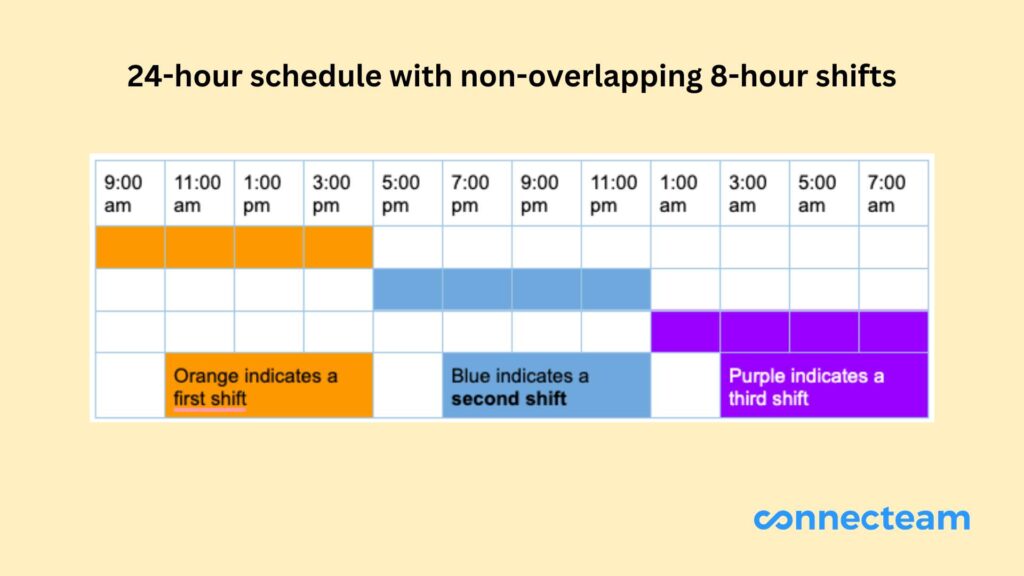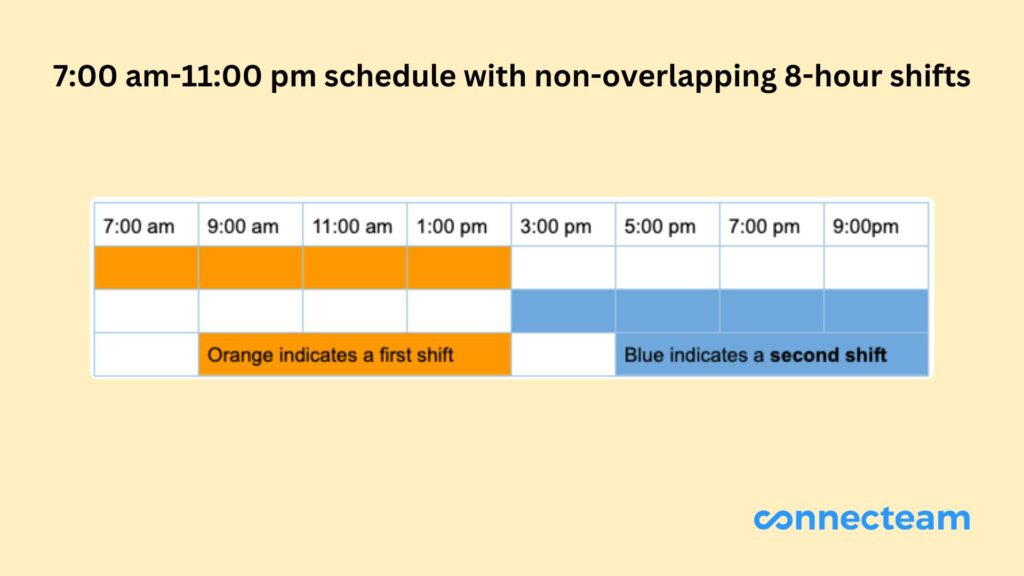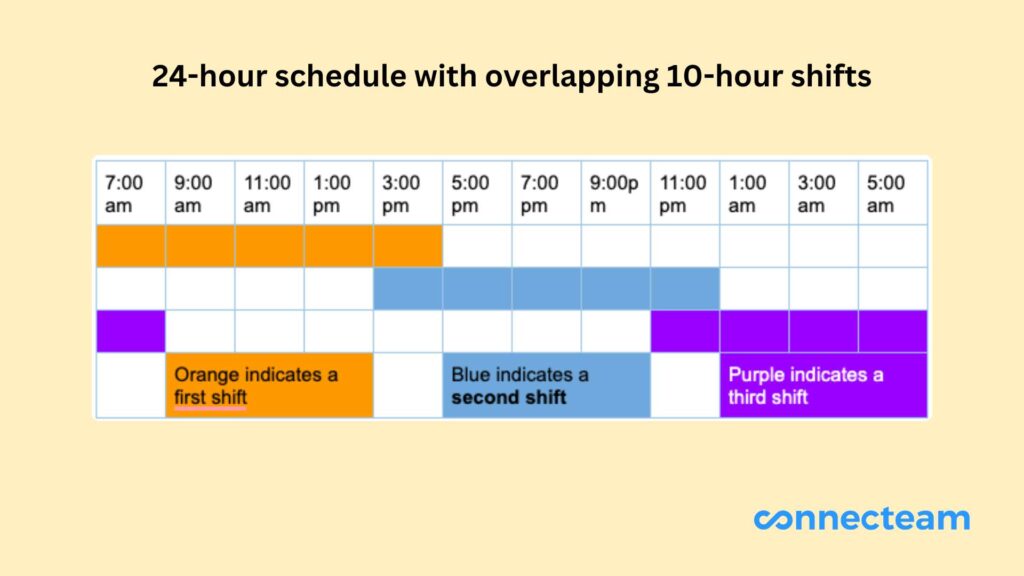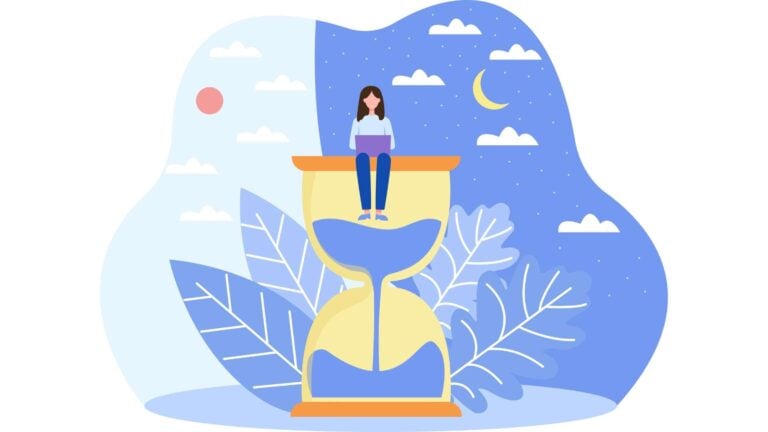A second shift is typically an afternoon or evening shift. This guide uncovers the pros and cons of adding a second shift into your work schedules and uncovers the steps needed for successful implementation.
Shift work plays a critical role in expanding operations beyond traditional business hours. A second shift offers a great deal of flexibility, but it also comes with downsides.
Below, we clarify how the second shift works for businesses and employees. We also discuss practical tips for implementing second shift (sometimes written 2nd shift) schedules and share examples of schedules that include second shifts.
Key Takeaways
- A second shift follows a first shift, typically starting between 3:00 pm and 5:00 pm—and ending between 11:00 pm and 1:00 am.
- Adopting a second shift helps businesses boost productivity and promotes knowledge transfer between overlapping shift workers.
- The 2nd shift can present scheduling challenges and requires a good understanding of local labor laws.
What Is a Second Shift? Hours and more
In shift work schedules, the second shift follows the morning shift or first shift. Employees typically start their 2nd shift hours in the late afternoon and end in the late evening, which is why this shift is often considered an evening or afternoon shift. However, some second shifts can begin earlier.
Businesses with extended or 24/7 operations use second shifts.
The second shift is often called the “swing shift” because it swings between day and night hours. However, second and swing shifts aren’t quite the same thing, as “second shift” is a more general term that refers to any shift following the first shift—it isn’t necessarily followed by a night shift.
Still, second shifts are traditionally used as swing shifts to cover the time between first and third shifts. In this case, the shift falls between traditional business hours and night work hours. If you break a day into 3 segments of 8 hours, for example, the second shift is the middle segment.
Oftentimes, second shifts ensure 24/7 coverage in 24-hour schedules that use shifts less than 12 hours. But the term is also sometimes used to refer to the second 12-hour shift in a 24-hour work schedule containing just day and night shifts. Here, the second shift is the night shift.
Some businesses that don’t operate 24/7 also use a second shift between opening and closing shifts to add staff during peak business hours. This is common in the restaurant, retail, and entertainment industries. For example, a retail business that sees higher foot traffic in the afternoon might add a second shift to bring in more help during this period.
Second shifts can vary in length but are usually 8-10 hours.
What time is the second shift?
An 8-hour second shift usually begins between 3:00 pm and 5:00 pm and ends between 11:00 pm and 1:00 am. Exact hours vary by industry and organization. For example, restaurants may have second shift workers start at 11:00 am to cover lunch rush.
Some second shift hours may overlap with other shifts. This is helpful in industries where knowledge exchange is vital between shift workers. For example, a hospital that uses 10-hour shifts might have a second shift nurse begin at 3:00 pm so their hours can overlap with the last 2 hours of the day shift nurse. In this case, the nurses can provide better patient care since they have time to ask questions or provide updates to each other.
Second Shift Examples





Industries Using a Second Shift
A 2nd shift extends hours to meet customer demand in industries that operate longer than traditional office hours, including restaurants, retail, and entertainment venues. Such businesses don’t usually have overnight third shift hours. Second shifts that conclude daily business operations in these industries might more commonly be called “closing shifts.”
A second shift is also widely used in 24/7 work environments, such as hospitals and public safety services. For healthcare and public safety, a second shift can help with providing emergency support outside traditional hours—sometimes without requiring longer individual shifts.
This schedule is also common in other industries that benefit from the increased production and efficiency second shifts offer—like manufacturing.
Did You Know?
McLaren Automotive implemented a second shift in their vehicle production center, bringing in 250 new employees. As a result, they doubled their daily production rate.
Second Shift Benefits
Benefits For Employers
Adding 2nd shift brings several advantages for employers, including:
- Improved productivity. In settings like manufacturing plants, the second shift allows for continuous use of facilities and equipment over a greater period of time each day.
- Extended service hours. Retail and hospitality employers reap the benefit of providing services to customers who want to visit their business in the late afternoon or evening.
- Scheduling flexibility. With more shift hours to choose from, finding overlap between employee availability and work hours can be easier.
- Smoother shift handover. Businesses that use the second shift to overlap with the first and third shifts enable employees working different shifts to share information and improve work performance.
Did You Know?
Connecteam’s team instant messaging features help employees share vital information on the go, making for more straightforward shift handovers.
Benefits for Employees
Benefits of working a second shift for employees include:
- Work-life flexibility. Balancing parenting demands, education, and personal passions can be easier for some employees when they don’t have to conform to traditional office hours. For instance, dispatcher Marty Piraino found that when he worked second shifts, he was able to schedule personal appointments and run errands in the morning.
- Sleep pattern improvement. A study published in the International Journal of Exercise Science found that a person’s sleep chronotype (i.e., when they wake up and sleep) influences their sleep quality. For those who naturally wake up later, working a second shift can be beneficial, as a second shift schedule better accommodates their preferred waking hours.
- Faster and cheaper commutes. Working non-standard hours can mean avoiding the morning and evening rush hour traffic jam. Public transit is also less expensive in some cities during non-peak hours.
- Higher wages and second jobs. Many employers offer incentive pay or higher wages to encourage employees toward the second shift. Some employees also capitalize on having early mornings available to work a second supplemental job.
One second shift employee wrote, “I’ve worked all 3 shifts. Seconds were great because I felt I had so much more freedom with my day… I always felt so guilty about not accomplishing anything after day shift because I was worn out. But with seconds, I was actually much more productive and happier.”
Second Shift Challenges
While beneficial in many ways, the second shift also presents challenges.
General challenges for employers
Employers need to be mindful that they’re staffing the right people in the second shift and ensure they create work schedules that provide adequate coverage.
- Employee retention. Exclusively working second shift works for some employees, but others may experience burnout or seek alternative first shift employment.
- Scheduling complexity. The second shift can also make scheduling more complicated—especially if your employees work more than one type of shift. Staffing your shifts correctly may require extra care.
- Management oversight. As the second shift expands the hours of business operation, it sometimes leads to hours when supervisors are less available. Staffing hours beyond traditional office hours with management-level employees can be challenging.
Did You Know?
Connecteam takes the guesswork out of shift scheduling. Previously scheduled shifts can be used as templates for creating new shift schedules. It’s also easy to set rules to avoid accidental overtime, insufficient break times, and more.
Legal challenges for employers
Various laws may impact how you implement a second shift schedule.
Some states have adopted labor laws that require employers to provide consistent schedules for employees. New York fast food businesses must provide workers with schedules that stay the same each week, for instance. Schedule changes in these businesses may also require premium pay. Laws like these may prevent employers from having employees rotate between second shifts and other shifts.
These laws are in addition to labor laws that apply in all states, such as overtime laws and meal and rest break laws.
You must also consider your employment contracts and any union agreements that cover your employees. For example, if your employment contract promises employees premium wages for less desirable shifts, you must fulfill that promise to avoid legal issues.
Consulting with a legal expert is the best way to determine which laws apply to your business.
This Might Interest You
Our state labor law guides are a useful reference to uncover scheduling laws in your state.
Challenges for employees
Some employees enjoy working a second shift, while others hate it. Those who prefer to avoid the second shift typically share these reasons.
- Disrupted social life. Consistently working while friends and family enjoy leisure time can take a toll on employee well-being.
- Fatigue. Some employees are drained by consistently working late into the evening.
One second shift worker wrote, “Basically from the time you get up until you go to work, you can’t really relax, and after you get home its so late anyway that you’ll probably want to sleep. [My second shift] was a horrible experience.”
How To Implement a Second Shift
Here are the key steps to successfully implementing a second shift.
Assess business needs
Determine why a second shift is necessary. Are you extending business hours? Creating an overlap shift to bridge your morning and night shifts? Identify the specific operational or service gaps that the second shift will address. Doing so first will help you develop schedules that meet your needs.
This will also help you determine what second shift hours look like for your business, including what time your second shift should start. For example, if you run a bar that experiences a happy hour rush, you’re more likely to schedule a second shift to start before 5:00 pm to meet that need.
Communicate with employees
Engage with your team about the upcoming changes. Explain the reasons for the second shift and how you plan to staff it. Be sure to address how it will benefit both the business and employees. Seek feedback and address any concerns they may have.
Plan schedules
Develop clear and consistent shift schedules. If necessary, ensure there’s adequate overlap between shifts to allow for smooth handovers. Use a scheduling app like Connecteam to manage shifts efficiently and reduce conflicts.
Recruit and train
You may need to hire additional staff to cover the second shift. Provide comprehensive employee training to ensure all employees are familiar with their responsibilities and safety protocols. Try to include some existing staff on the new shift to ensure institutional knowledge is shared effectively.
Offer incentives
To attract employees to the second shift, consider offering incentives. Shift differentials (higher pay for working less desirable hours) are commonly used to encourage employees to volunteer for second shift. You can also consider offering additional time off or other benefits.
Evaluate performance
Regularly check in with second shift employees to gauge their well-being. Evaluate key performance indicators like absenteeism, productivity, and customer satisfaction to ensure the shift is meeting business goals.
Pro Tip
Since the second shift falls outside traditional office hours, unnecessary overtime can creep in if no one is keeping watch. Use the Connecteam overtime app to accurately track overtime and get notified if a second shift employee dips into unapproved overtime.
Flexible Shift Hours and Alternative Shift Patterns
Here’s what you need to know about other shift hours and shift patterns that go along with second shifts.
Part-time hours
Hiring employees for part-time employment can help fill out second shift needs. For instance, you might schedule a part-time employee for just the evening dinner rush hours in your restaurant. Alternatively, part-time employees may work 8-hour shifts but work only on your busiest days each week.
Weekend hours
As with part-time employees, some businesses hire employees to work exclusively on weekends. This can help retail businesses cope with higher customer demand on weekends. Some businesses schedule all employees on both weekdays and weekends. It’s important to be mindful of state laws, like Illinois’ labor laws, that require employers to grant at least 1 day off per 7 days worked.
First shift
First shift employees work hours that overlap with traditional office hours—usually between 7:00 am and 6:00 pm. The first shift can include part-time or weekend hours work.
Third shift
This is the overnight shift, sometimes ominously called the graveyard shift. Third shift hours typically run between 11:00 pm and 8:00 am. These hours are common in 24/7 businesses and public services. As with the first shift, the third shift sometimes includes part-time or weekend work.
Split shift
A split shift can fall across first, second, or third shift hours. The defining feature of a split shift is that it divides total hours into 2 blocks of work hours with a long period off in the middle. For example, an employee on a split shift might work 8:00 am-12:00 pm and 6:00 pm-10:00 pm on the same day.
Some states, like California, require premium pay for some employees scheduled on to split shifts.
Fixed shift
A fixed shift occurs when an employee has the same shift assignment week after week. If you allow an employee to work second shifts only, they’d have a fixed second shift.
Rotating shift
Many businesses need scheduling flexibility to balance employee availability and business needs. A rotating shift means that employees are scheduled to change shifts each week. For example, an employee may be assigned to a mix of first and second shift hours in the same week.
For rotating shifts, keep in mind that some states require you to pay premiums when employees work “clopening” schedules: closing the business one night and opening it the next day.
The Bottom Line on the Second Shift
The second shift helps extend operational hours and improve product and service delivery for many businesses. It can boost productivity and promote better resource use. However, it requires an understanding of local labor laws and can be disruptive for employees.
Successful implementation of the second shift requires thoughtful scheduling, clear communication, and supportive management practices.
Crafting schedules that work for your business and employees is easier with Connecteam. Manage scheduling needs and keep your employees in the loop in one app.




